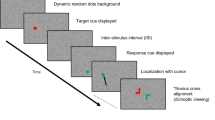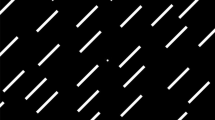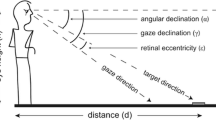Abstract
The purpose of this work is to compare the relative contributions from the extraocular and sensory systems on the magnitude of the horizontal–vertical illusion (HVI). The visual HVI refers to the general tendency to overestimate vertical extensions of small-scale lines on a picture plane relative to the horizontal by 4–16% depending on the method of measurement. The HVI line stimuli consisted of luminous vertical and horizontal lines forming “L-profiles” located in the frontoparallel plane at a 45 cm viewing distance, collinearly with a binocular gaze. The home position of gaze was aligned to the center of the screen with the ear–eye angle concordant with the environmental horizontal. Illusion strength was quantified when subjects fixated the HVI line stimuli in four quadrants of the visual field. The HVI was also viewed through prism lenses that inverted the retinal images by 180°, thereby dissociating the sensory “up-down” direction from the oculomotor up-down frame of reference. The results revealed a systematically lower magnitude of the HVI in the bottom visual field regardless of whether subjects fixated the HVI with the distorting prisms or without. Taken together, these results suggest that the HVI is sensitive to small-angle gaze shifts. In agreement with several recent findings, these results are interpreted as implying that the brain imposes an enhanced analytic structure on the ascending sensory information during downward gaze.



Similar content being viewed by others
References
Andersen RA, Snyder LH, Bradley DC, Xing J (1997) Multimodal representation of space in the posterior parietal cortex and its use in planning movements. Annu Rev Neurosci 20:303–330
Andersen RA, Mountcastle VB (1983) The influence of the angle of gaze upon the excitability of the light-sensitive neurons of the posterior parietal cortex. J Neurosci. 3:532–548
Andersen RA, Essick GK, Siegel RM (1985) Encoding of spatial location by posterior parietal neurons. Science 25:456–458
Armstrong L, Marks E (1997) Differential effects of stimulus context on perceived length: implications for the horizontal-vertical illusion. Percept Psychophys 59:1200–1213
Atchison DA, Claydon CA, Irwin SE (1994) Amplitude of accommodation for different head positions and different directions of eye gaze. Optom Vis Sci 71:339–345
Attneave F, Block G (1974) The time required to compare extents in various orientations Percept Psychophys 16:431–436
Binsted G, Heath M (2005) No evidence of a lower visual field specialization for visuomotor control. Exp Brain Res 162:89–94
Brotchie PR, Andersen RA, Snyder LH, Goodman SJ (1995) Head position signals used by parietal neurons to encode locations of visual stimuli. Nature 18:232–235
Dankert J, Goodale MA (2001) Superior performance for visually guided pointing in the lower visual field. Exp Brain Res 137:303–308
Galletti C, Kutz DF, Gamberini M, Breveglieri R, Fattori P (2003) Role of the medial parieto-occipital cortex in the control of reaching and grasping movements. Exp Brain Res 153:158–170
Girgus JS, Coren S (1975) Depth cues and constancy scaling in the horizontal-vertical illusion: the bisection error. Can J Psychol 29(1):59–65
Von Grünau M, Dubé S (1994) Visual search asymmetry for viewing direction. Percept Psychophys 56:211–220
Goodale MA, Milner AD (1992) Separate visual pathways for perception and action. Trends Neurosci 15:20–25
Guski R, Rudolph R, Schindauer T (1993) Zur Funktionalität der “Vertikalen-Täuschung” [The functional aspects of horizontal-vertical illusion]. Ruhr-Universität Bochum, Fakultät für Psychologie
Handy TC, Grafton ST, Shroff NM, Ketay S, Gazzaniga MS (2003) Graspable objects grab attention when the potential for action is recognized. Nat Neurosci 6:421–427
He S, Cavanagh P, Intriligator J (1996) Attentional resolution and the locus of visual awareness. Nature 26:334–337
Higashiyama A (1996) Horizontal and vertical distance perception: the discorded-orientation theory. Percept Psychophys 58:259–270
Imamura K, Onoe H, Watanabe Y, Richter H, Andersson J, Fischer H, Magnusson S, Okura K, Schneider H, Fredrikson M, Långström B (2000) Pet imaging of the adaptation to prism-induced inverted vision. Invest Ophthalmol Vis Sci 39:1047
Khan MA, Lawrence GP (2005) Differences in visuomotor control between the upper and lower visual fields. Exp Brain Res 164:395–398
Kohler I, Pissarek T (1960) Brillenversuche zur Vertikalentäuschung [Spectacle experiments on horizontal-vertical illusion]. Psychol Beiträge 5:117–140
Kubi E, Slotnick BM (1993) The horizontal-vertical illusion: transfer of illusion decrement. Percept Mot Skills 77:339–347
Künnapas TM (1959) The vertical-horizontal illusion in artificial visual fields. J Psychol 47:41–48
Lipshits M, McIntyre J, Zaoui M, Gurfinkel V, Berthoz A (2001) Does gravity play an essential role in the asymmetrical visual perception of vertical and horizontal line length? Acta Astronaut 49:123–130
Levine MW, McAnany JJ (2005) The relative capabilities of the upper and lower visual hemifields. Vision Res 45(21):2820–2830
Mishkin M, Ungerleider LG (1982) Contribution of striate inputs to the visuospatial functions of parieto-preoccipital cortex in monkeys. Behav Brain Res 6:57–77
Merriam EP, Colby CL (2005) Active vision in parietal and extrastriate cortex. Neuroscientist 11:484–489
Portin K, Vanni S, Virsu V, Hari R (1999) Stronger occipital cortical activation to lower than upper visual field stimuli. Exp Brain Res 124:287–294
Previc FH (1990) Functional specialization in the lower and upper visual fields in humans: its ecological origins and neurophysiological implications. Behav Brain Sci 13:519–575
Previc FH (1998) The neuropsychology of 3-D space. Psychol Bull 124:123–164
Raudsepp J (2001) Peripersonal horizontal-vertical illusions: towards comparable kinesthetic and visual task. J Hum Mov Stud 41:263–286
Raudsepp J, Djupsjöbacka M (2005) Handgrip maximum force and the visual horizontal-vertical illusion. Perception 34(4):421–428
Richter H, Lee JT, Pardo J (2000) Central correlates of voluntary visual accommodation in humans measured with 15O-water and PET. Eur J Neurosci 12:311–321
Richter H, Magnusson S, Imamura K, Fredrikson M, Okura M, Watanabe Y, Långström B (2002) Mental rotation and natural motor performance following successive stages of long term adaptation to prism reversed vision. Exp Brain Res 144:445–457
Schuller AM, Rossion B (2005) Spatial attention triggered by eye gaze enhances and speeds up visual processing in upper and lower visual fields beyond early striate visual processing. Clin Neurophysiol 116:2565–2576
Servos P, Carnahan H, Fedwick J (2000) The visuomotor system resists the horizontal-vertical illusion. J Mot Behav 32:400–404
Talgar CP, Carrasco M (2002) Vertical meridian asymmetry in spatial resolution: visual and attentional factors. Psychon Bull Rev 9:714–722
Trotter Y, Celebrini S (1999) Gaze direction controls response gain in primary visual-cortex neurons. Nature 18:239–242
Acknowledgments
This work was supported in part by grants from the University of Gävle, Gävle, Sweden, Project grant 55-743-04 as well as the Swedish Council for Working Life and Social Research Grant 2005-0488 to HR. We thank our volunteers for their generosity and patience. Barbara Rosborg is acknowledged for her skilled proof reading.
Author information
Authors and Affiliations
Corresponding author
Additional information
Hans O. Richter and Jaanus Raudsepp contributed equally to this work.
Rights and permissions
About this article
Cite this article
Richter, H.O., Wennberg, P. & Raudsepp, J. The effects of inverting prisms on the horizontal–vertical illusion: a systematic effect of downward gaze. Exp Brain Res 183, 9–15 (2007). https://doi.org/10.1007/s00221-007-1015-z
Received:
Accepted:
Published:
Issue Date:
DOI: https://doi.org/10.1007/s00221-007-1015-z




